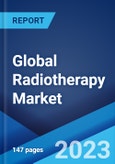The global radiotherapy market size reached US$ 6.5 Billion in 2022. Looking forward, the market is expected to reach US$ 8.5 Billion by 2028, exhibiting a growth rate (CAGR) of 4.57% during 2022-2028.
Radiotherapy, also known as radiation therapy, is used to slow down the growth of cancer cells and shrink tumors. It destroys the genetic material of cancer cells using high-energy particles or waves, such as x-rays, gamma rays, electron beams, or protons. It can be combined with other cancer treatments, such as surgery, chemotherapy, and immunotherapy, to improve their effectiveness. At present, it is offered to patients depending on their cancer type, size and location of the tumor, medical history, and age and medical conditions.
Radiotherapy, also known as radiation therapy, is used to slow down the growth of cancer cells and shrink tumors. It destroys the genetic material of cancer cells using high-energy particles or waves, such as x-rays, gamma rays, electron beams, or protons. It can be combined with other cancer treatments, such as surgery, chemotherapy, and immunotherapy, to improve their effectiveness. At present, it is offered to patients depending on their cancer type, size and location of the tumor, medical history, and age and medical conditions.
Radiotherapy Market Trends
The rising prevalence of cancer on account of unhealthy dietary patterns, lack of physical activities, growing air pollution, and the increasing number of alcohol and tobacco consumption represents one of the key factors strengthening the growth of the market. Moreover, the risk of developing cancer rises dramatically with age as the tendency for cellular repair is less effective in older individuals. As a result, the rising geriatric population across the globe is acting as another significant growth-inducing factor. Apart from this, the development of effective, low-cost, and easy-to-use radiotherapy products is bolstering the growth of the market growth. In addition, modern radiotherapy techniques, such as three-dimensional (3D) conformal, intensity-modulated, and image-guided, deliver a lower dose of radiation to healthy tissues while a higher dose to the tumor. They also improve organ-at-risk (OAR) sparing and provide no physical sensation to patients. This is increasing their adoption in multiple applications and settings in chronic disease treatment, which, in turn, is catalyzing the demand for radiotherapy around the world. Furthermore, the market is projected to experience growth on account of the rising healthcare expenditure in both emerging and developed economies.Key Market Segmentation
This research provides an analysis of the key trends in each sub-segment of the global radiotherapy market report, along with forecasts at the global, regional and country level from 2023-2028. The report has categorized the market based on type, application and end user.Breakup by Type:
- External Beam Radiation Therapy
- Intensity-Modulated Radiation Therapy (IMRT)
- Image-Guided Radiation Therapy (IGRT)
- Tomotherapy
- Stereotactic Radiosurgery
- Stereotactic Body Radiation Therapy
- Proton Therapy
- 3D Conformal Radiotherapy (3D CRT)
- Volumetric Modulated Arc Therapy (VMAT)
- Internal Radiation Therapy/Brachytherapy
- Systemic Radiation Therapy
Breakup by Application:
- Skin and Lip Cancer
- Head and Neck Cancer
- Breast Cancer
- Prostate Cancer
- Cervical Cancer
- Lung Cancer
Breakup by End User:
- Hospitals
- Cancer Research Institutes
- Ambulatory and Radiotherapy Centers
Breakup by Region:
- North America
- United States
- Canada
- Asia-Pacific
- China
- Japan
- India
- South Korea
- Australia
- Indonesia
- Europe
- Germany
- France
- United Kingdom
- Italy
- Spain
- Russia
- Latin America
- Brazil
- Mexico
- Middle East and Africa
Competitive Landscape
The competitive landscape of the industry has also been examined along with the profiles of the key players being Accuray Incorporated, Becton Dickinson and Company, Eckert & Ziegler, Elekta AB (publ), General Electric Company, Hitachi Ltd, Ion Beam Applications, Isoray Inc., Mevion Medical Systems Inc., Nordion Inc. (Sotera Health) and Siemens Healthineers AG (Siemens AG).Key Questions Answered in This Report:
- How has the global radiotherapy market performed so far and how will it perform in the coming years?
- What has been the impact of COVID-19 on the global radiotherapy market?
- What are the key regional markets?
- What is the breakup of the market based on the type?
- What is the breakup of the market based on the application?
- What is the breakup of the market based on the end user?
- What are the various stages in the value chain of the industry?
- What are the key driving factors and challenges in the industry?
- What is the structure of the global radiotherapy market and who are the key players?
- What is the degree of competition in the industry?
Table of Contents
1 Preface3 Executive Summary11 Value Chain Analysis13 Price Analysis
2 Scope and Methodology
4 Introduction
5 Global Radiotherapy Market
6 Market Breakup by Type
7 Market Breakup by Application
8 Market Breakup by End User
9 Market Breakup by Region
10 SWOT Analysis
12 Porters Five Forces Analysis
14 Competitive Landscape
Companies Mentioned
- Accuray Incorporated
- Becton Dickinson and Company
- Eckert & Ziegler
- Elekta AB (publ)
- General Electric Company
- Hitachi Ltd
- Ion Beam Applications
- Isoray Inc.
- Mevion Medical Systems Inc.
- Nordion Inc. (Sotera Health)
- Siemens Healthineers AG (Siemens AG)
Methodology

LOADING...
Table Information
| Report Attribute | Details |
|---|---|
| No. of Pages | 147 |
| Published | November 2023 |
| Forecast Period | 2022 - 2028 |
| Estimated Market Value ( USD | $ 6.5 Billion |
| Forecasted Market Value ( USD | $ 8.5 Billion |
| Compound Annual Growth Rate | 4.6% |
| Regions Covered | Global |
| No. of Companies Mentioned | 11 |









